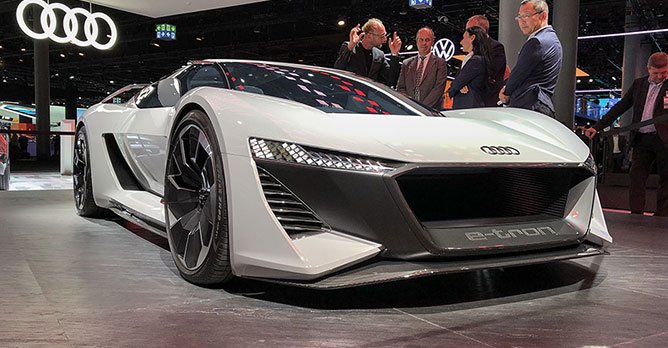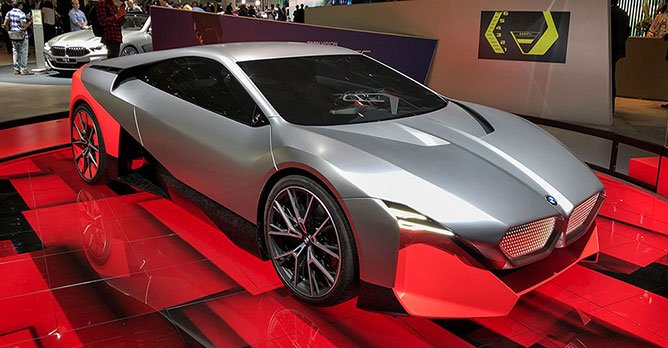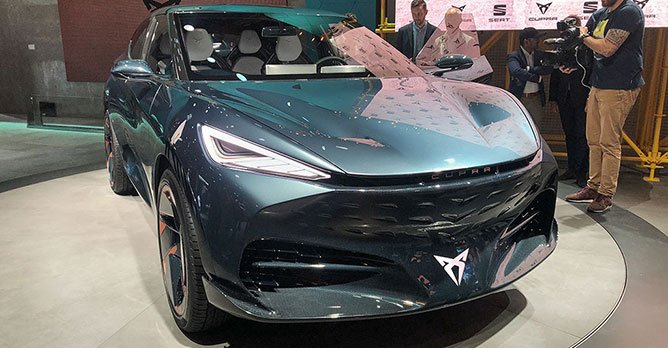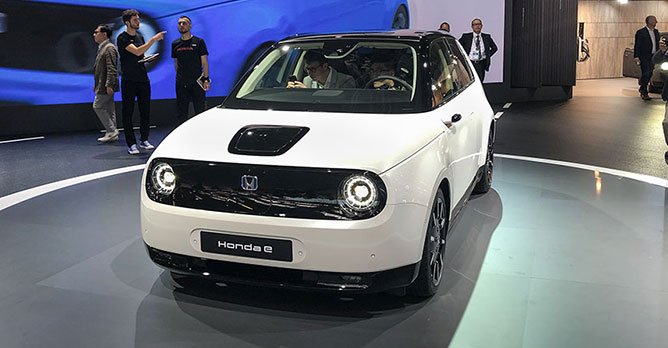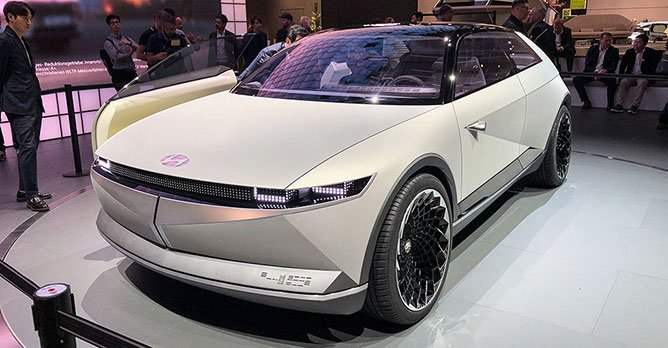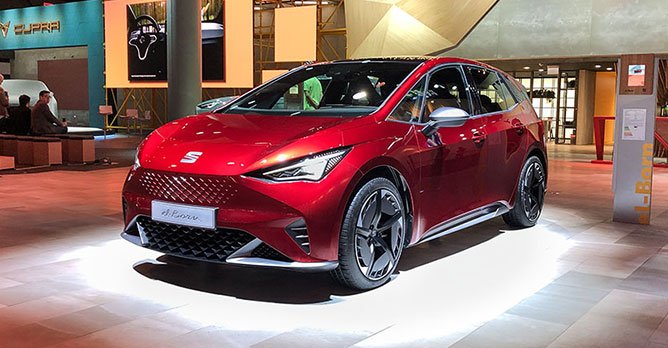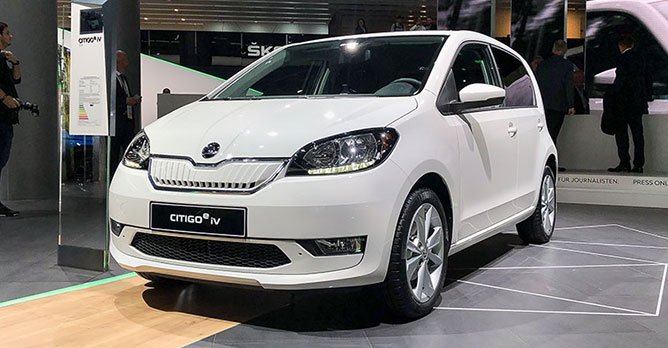Frankfurt Motor Show 2019: Electric mobility
13 Sep 2019|16,064 views
In line with its theme 'Driving tomorrow', this year's Frankfurt Motor Show (IAA) showcases more than just the regular car model premieres. Instead, the exhibition, which covers an area of a whopping 168,000sqm, focuses on a new ecosystem of mobility. This includes electric mobility as well as alternative powertrains.
Here are some of the 'green' highlights of this year's IAA that exemplify their nature of going beyond regular mobility.
Audi AI:Race
The Audi AI:Race is a high-performance sports car with electric drive that allows for the perfect seating position when driven solo. The driver's seat and cockpit are integrated into an inner monocoque shell that can be slid laterally. Thus, the monocoque can be positioned in the centre of the interior.
The concept uses three powerful electric motors - one in front and two in the rear, delivering a power output of up to 200bhp to the front axle and 470bhp to the rear. The car's total output is 670bhp and 830Nm of torque. With boosting, the driver can temporarily mobilise up to a whopping 765bhp. This sees to a century sprint of just two seconds.
The AI:Race has a range of up to 500km and, like the Porsche Taycan, is already designed for charging with a voltage of 800V. Hence, the battery can be fully recharged in about 15 minutes.
BMW Vision M NEXT
Alongside the BMW Concept 4 is the futuristic BMW Vision M NEXT. But unlike any other M cars, this concept comes with a plug-in hybrid heart - showcasing the M brand's electrified future.
Power is ample, as you would expect. System output of 591bhp produces a top speed of 300km/h and enables the car to sprint from 0-100km/h in just three seconds. More impressively, this can be done with either all-electric propulsion or the power of a turbocharged four-cylinder petrol engine.
There is also a Boost+ mode that puts extra power on tap at the push of a button. Range wise, the maximum driving distance in pure electric mode is 100km - more than enough to commute to work and then head home purely on electric power in Singapore.
Cupra Tavascan Concept
Making its world debut at the IAA, the pure electric Cupra Tavascan Concept is a coupe SUV that's based on the Volkswagen Group's MEB platform and it provides a unique vision of the brand's high-performance, electrified future.
Impressively, it will also be the first road Cupra to use a fully electric powertrain when it goes into production.
Two motors - one integrated on the front axle, the second at the rear - provide a combined 306bhp of power to all four wheels, allowing the car to complete the zero - 100km/h in less than 6.5 seconds.
More relevantly, the Concept houses a 77kWh lithium-ion battery pack that will see to the vehicle's range of up to 450km - a figure based on the stringent WLTP test cycle.
Honda e
Making its official public debut at the IAA, the new production fully electric Honda e is a compelling car for the future indeed.
Equipped with an electric motor available with two choices of power outputs of 132bhp or 149bhp, and an impressive torque of 315Nm, the Honda e is capable of delivering a range of up to 220km from its compact 35.5kWh battery. A fast charge option capability is also available to recharge the car up to 80% capacity in 30 minutes.
Design wise, the car looks like nothing on the road, thanks to its futuristic yet modern design. It's the same on the inside. The Honda e's full-width digital dashboard is occupied by dual 12.3-inch LCD touchscreens that are incorporated within a relaxing cabin that uses contemporary materials.
Hyundai 45
This retro-futuristic electric vehicle concept by Hyundai is a blast from the past. It is inspired by the Hyundai Pony Coupe Concept, a 45-year old icon, to introduce a new in-car experience in a modern world.
The concept car's name also owes itself in part to the 45-degree angles at the front and rear, which form a diamond-shaped silhouette that foreshadows Hyundai's design direction for future electric models.
The interior also points to an autonomous future. The generous space all around are meant to mimic a living room, with lounge chair-style rear and front seats that can rotate to face one another. This is largely thanks tothe position of the batteries and motors below the passenger compartment.
Whether the production vehicle of the 45 will be autonomous-capable remains to be uncertain for now.
Seat el-Born
The el-Born concept car is Seat's first all-electric vehicle that highlights the brand's focus to provide sustainable mobility in an ever changing world.
Based on the Volkswagen Group's MEB platform, the concept car has a power output of 204bhp and can reach 100km/h in a decent 7.5 seconds. But this electric vehicle shouldn't be solely judged on its performance. Instead, its ability to maximise its range on a single charge and minimise the time taken to recharge its batteries should also be considered.
With a practical range of between 300km and 420 km, thanks to its 58kWh battery, the Seat el-Born provides a decent range for urban and city driving. Fast charging of just 30 minutes will pump the Seat's juice level to appromimately 80%.
Skoda CITIGOe iV
As its first ever all-electric production vehicle, it's clear that Skoda is embarking on a new era of its 124-year history.
The Skoda CITIGOe iV has a 60Ah lithium-ion battery with a capacity of 36.8kWh, which allows it to make its city runs up to a range of 265km. The battery can be recharged to 80% in one hour using a 40kW DC fast charger.
Like the Honda e, this compact Skoda is perfect for modern cities such as Singapore. Not only can it haul four occupants with comfort, it also offers 250 litres worth of boot space.
The four-seater city car is powered exclusively by a 61kW electric motor, delivering a maximum torque of 210Nm.
In line with its theme 'Driving tomorrow', this year's Frankfurt Motor Show (IAA) showcases more than just the regular car model premieres. Instead, the exhibition, which covers an area of a whopping 168,000sqm, focuses on a new ecosystem of mobility. This includes electric mobility as well as alternative powertrains.
Here are some of the 'green' highlights of this year's IAA that exemplify their nature of going beyond regular mobility.
Audi AI:Race
The Audi AI:Race is a high-performance sports car with electric drive that allows for the perfect seating position when driven solo. The driver's seat and cockpit are integrated into an inner monocoque shell that can be slid laterally. Thus, the monocoque can be positioned in the centre of the interior.
The concept uses three powerful electric motors - one in front and two in the rear, delivering a power output of up to 200bhp to the front axle and 470bhp to the rear. The car's total output is 670bhp and 830Nm of torque. With boosting, the driver can temporarily mobilise up to a whopping 765bhp. This sees to a century sprint of just two seconds.
The AI:Race has a range of up to 500km and, like the Porsche Taycan, is already designed for charging with a voltage of 800V. Hence, the battery can be fully recharged in about 15 minutes.
BMW Vision M NEXT
Alongside the BMW Concept 4 is the futuristic BMW Vision M NEXT. But unlike any other M cars, this concept comes with a plug-in hybrid heart - showcasing the M brand's electrified future.
Power is ample, as you would expect. System output of 591bhp produces a top speed of 300km/h and enables the car to sprint from 0-100km/h in just three seconds. More impressively, this can be done with either all-electric propulsion or the power of a turbocharged four-cylinder petrol engine.
There is also a Boost+ mode that puts extra power on tap at the push of a button. Range wise, the maximum driving distance in pure electric mode is 100km - more than enough to commute to work and then head home purely on electric power in Singapore.
Cupra Tavascan Concept
Making its world debut at the IAA, the pure electric Cupra Tavascan Concept is a coupe SUV that's based on the Volkswagen Group's MEB platform and it provides a unique vision of the brand's high-performance, electrified future.
Impressively, it will also be the first road Cupra to use a fully electric powertrain when it goes into production.
Two motors - one integrated on the front axle, the second at the rear - provide a combined 306bhp of power to all four wheels, allowing the car to complete the zero - 100km/h in less than 6.5 seconds.
More relevantly, the Concept houses a 77kWh lithium-ion battery pack that will see to the vehicle's range of up to 450km - a figure based on the stringent WLTP test cycle.
Honda e
Making its official public debut at the IAA, the new production fully electric Honda e is a compelling car for the future indeed.
Equipped with an electric motor available with two choices of power outputs of 132bhp or 149bhp, and an impressive torque of 315Nm, the Honda e is capable of delivering a range of up to 220km from its compact 35.5kWh battery. A fast charge option capability is also available to recharge the car up to 80% capacity in 30 minutes.
Design wise, the car looks like nothing on the road, thanks to its futuristic yet modern design. It's the same on the inside. The Honda e's full-width digital dashboard is occupied by dual 12.3-inch LCD touchscreens that are incorporated within a relaxing cabin that uses contemporary materials.
Hyundai 45
This retro-futuristic electric vehicle concept by Hyundai is a blast from the past. It is inspired by the Hyundai Pony Coupe Concept, a 45-year old icon, to introduce a new in-car experience in a modern world.
The concept car's name also owes itself in part to the 45-degree angles at the front and rear, which form a diamond-shaped silhouette that foreshadows Hyundai's design direction for future electric models.
The interior also points to an autonomous future. The generous space all around are meant to mimic a living room, with lounge chair-style rear and front seats that can rotate to face one another. This is largely thanks tothe position of the batteries and motors below the passenger compartment.
Whether the production vehicle of the 45 will be autonomous-capable remains to be uncertain for now.
Seat el-Born
The el-Born concept car is Seat's first all-electric vehicle that highlights the brand's focus to provide sustainable mobility in an ever changing world.
Based on the Volkswagen Group's MEB platform, the concept car has a power output of 204bhp and can reach 100km/h in a decent 7.5 seconds. But this electric vehicle shouldn't be solely judged on its performance. Instead, its ability to maximise its range on a single charge and minimise the time taken to recharge its batteries should also be considered.
With a practical range of between 300km and 420 km, thanks to its 58kWh battery, the Seat el-Born provides a decent range for urban and city driving. Fast charging of just 30 minutes will pump the Seat's juice level to appromimately 80%.
Skoda CITIGOe iV
As its first ever all-electric production vehicle, it's clear that Skoda is embarking on a new era of its 124-year history.
The Skoda CITIGOe iV has a 60Ah lithium-ion battery with a capacity of 36.8kWh, which allows it to make its city runs up to a range of 265km. The battery can be recharged to 80% in one hour using a 40kW DC fast charger.
Like the Honda e, this compact Skoda is perfect for modern cities such as Singapore. Not only can it haul four occupants with comfort, it also offers 250 litres worth of boot space.
The four-seater city car is powered exclusively by a 61kW electric motor, delivering a maximum torque of 210Nm.
Thank You For Your Subscription.








